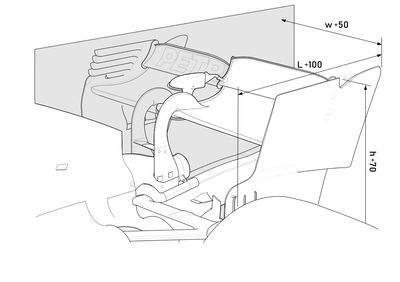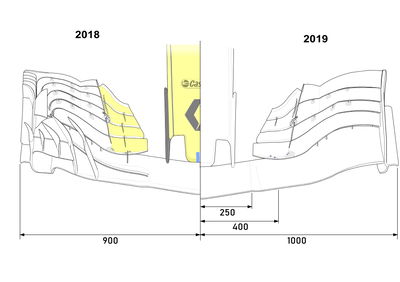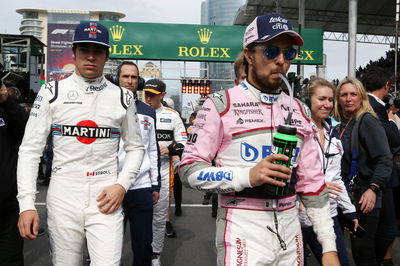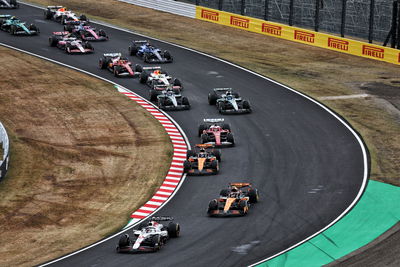How F1's 2019 rule changes aim to spice up racing
Next season’s technical regulation changes mark the first steps towards Ross Brawn’s vision of what Formula 1 cars should be from an engineering perspective.
While the dramatic overhaul of the aerodynamic rules in 2017 were invented purely for aesthetics and speed, the 2019 regulations are aimed at improving the on-track spectacle, although there is expected to be a small resultant speed penalty.

Next season’s technical regulation changes mark the first steps towards Ross Brawn’s vision of what Formula 1 cars should be from an engineering perspective.
While the dramatic overhaul of the aerodynamic rules in 2017 were invented purely for aesthetics and speed, the 2019 regulations are aimed at improving the on-track spectacle, although there is expected to be a small resultant speed penalty.
Unlike previous occasions, the following regulation revisions are born out of extensive research into the dynamics of F1 cars following each other. Brawn’s engineering team have utilised CFD and wind tunnel data to assess what aspects of the car are causing the most turbulence, and how this can be reduced without completely rewriting the rulebook – that, of course, will likely happen in 2021.

Front wing
Brawn’s team have identified the front wing as being the key source of F1’s overtaking problem, or rather the lack of. Ironically, the seeds of this problem were first sown back when new rules were introduced to try to improve racing in 2009.
While the simpler bodywork and taller rear wings had their merits, the much wider and lower front wing allowed the teams to begin exploring the use of wing tip vortices to create even more front downforce than ever before.
There is certainly a benefit in keeping the position of the front wing where it is: they are far less affected by the turbulent wake of the car in front being that low to the ground. However, the adjustments to the rules that will be implemented next year aim to prevent complex vortex structures forming which add to the chaotic areas within the car’s turbulent wake.
The key dimensional changes are:
- +200 mm wider – the wing is now the same width as the car (2 metres)
- +25 mm forward
- +25 mm overall height increase
The width change harks back to 2009 – it makes sense because the wing won’t have to work the air as hard to push it around the front tyre. There is also more surface area available to claw back any downforce losses from this year. Moving the wing forward slightly will also help, as the air needn’t be turned as aggressively ahead of the front tyre for it to pass successfully around.
As for raising the overall height of the wing – in the same way they have done with the rear wing, which will be discussed later – I see this as a way to increase the drag of the car to make the slipstream effect more powerful.
Slowing the cars on the straight also increases the time the drivers can be engaged in combat, which is arguably why lower formulae produce better racing than F1. It will also offer more surface area to regain the downforce loss.
Aside from the primary dimension changes, there are a lot of carefully worded rules on other aspects of the front wing. So many, in fact, that there is probably enough discussion for two articles just on the front wing alone.
In my mind, the critical regulations that will determine the fundamental shape of the wings are:
- Five elements maximum
- Heavily governed area 400 mm from the car centreline outwards
- Almost fully defined endplates consisting of a vertical fence and footplate
- Maximum two under-wing strakes within a specified zone
- Regulated ‘auxiliary components’, such as brackets, slot gap separators, flap angle adjusters etc.
Firstly, implementing a maximum number of elements really hampers how aggressively the air can be manipulated. We have seen as many as nine elements to the front wings in recent years, the multiple slot gaps designed to feed additional air to the underside of the wing and prevent stalling at high angles of attack.
Interestingly, the inboard section of the wing remains fairly open, and we will no doubt continue to see complex layering of intricately designed flaps to induce a strong Y250 vortex. From 400 mm outwards, though, there is little scope to be as creative. The extravagant designs along the outboard section of the wing will be obsolete, preventing aerodynamicists from creating finely tuned vortices rolling up and interacting with the air flowing over endplate.
Wing tip vortices have long been known to be detrimental to the lift characteristics of the wing. This goes for aeroplanes too, which is why you often see little endplates on the wings of passenger jets to increase their efficiency.
However, in recent years the motorsport world has since recognised that these vortices can be applied in a very desirable way to pull airflow wherever they please. These vortices also boost the suction effect of the wing and allow for greater angles of attack before stall occurs.
To stop this fad, the FIA have clearly defined what an endplate is in the new regulations, and how you can use the space in which they occupy. This ‘barrier’ will impede the development of wing tip vortices. Cascade winglets and turning vanes are also barred for next year, further preventing the development of such tip vortices as they can no longer be fed with additional airflow using such devices. The curvature of the endplate has been capped at 15 degrees and must fit in a space 910-950 mm from the car centreline, leaving an exposed portion of the footplate to fulfil the remaining width of the wing.
Multiple underside strakes have also been picked out as a problem with the front wing wake. There is now a zone between 500 and 800 mm from the car centreline for up to two strakes; each strake must fit within two parallel planes 20 mm apart, with a maximum curvature of 10 degrees. Even the relative proximity of the strakes have been defined.
Follow Page 2 for the full 2019 F1 technical rules feature...











